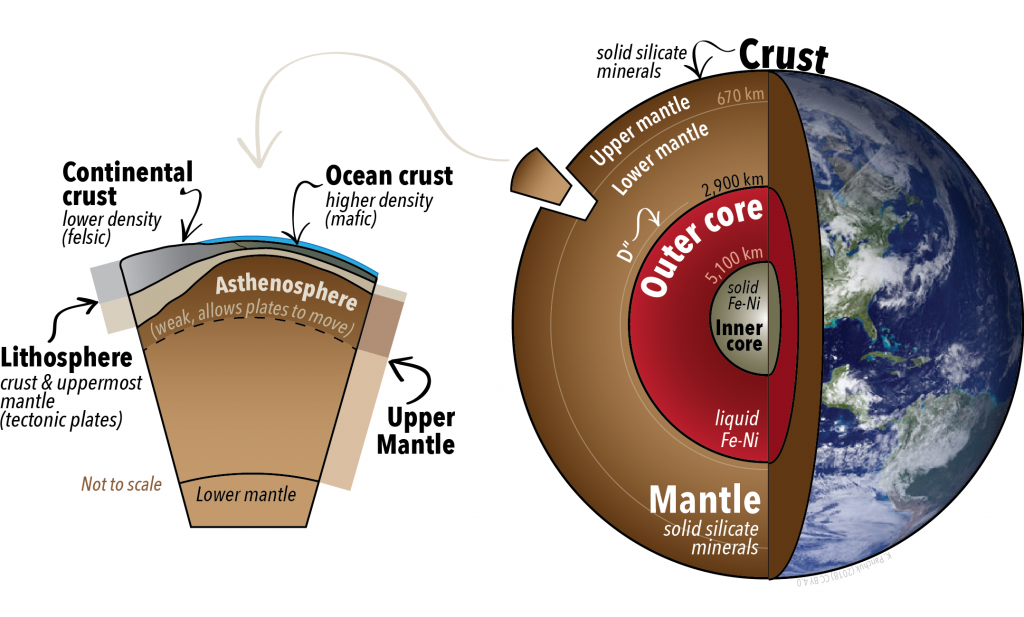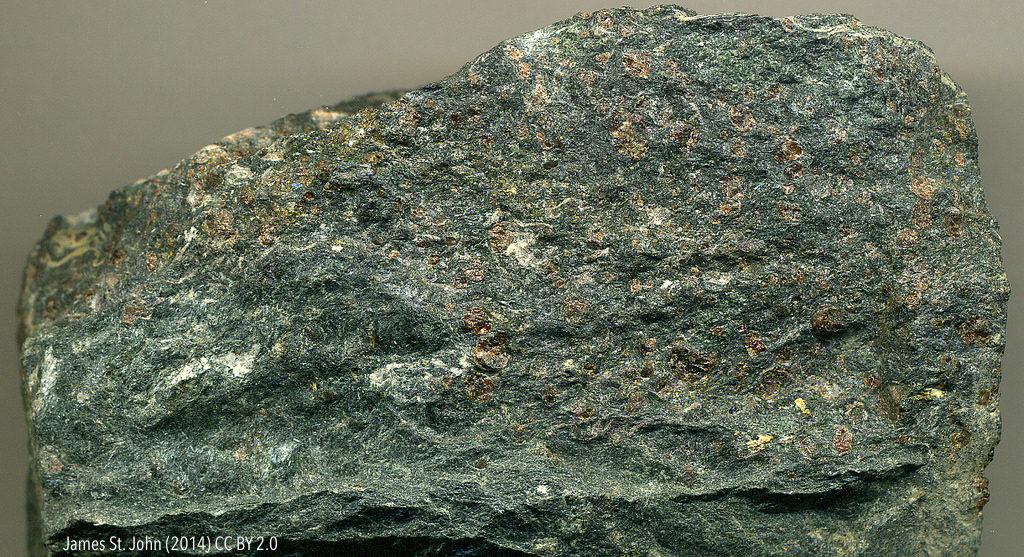3.1 Earth’s Layers: Crust, Mantle, and Core
Earth consists of three main layers: the crust, the mantle, and the core (Figure 3.3). The core accounts for almost half of Earth’s radius, but it amounts to only 16.1% of Earth’s volume. Most of Earth’s volume (82.5%) is its mantle, and only a small fraction (1.4%) is its crust.

Crust
The Earth’s outermost layer—its crust—is rocky and rigid. There are two kinds of crust: continental crust, and ocean crust. Continental crust is thicker, and predominantly felsic in composition, meaning that it contains minerals that are richer in silica. The composition is important because it makes continental crust less dense than ocean crust.
Ocean crust is thinner, and predominantly mafic in composition. Mafic rocks contain minerals with less silica, but more iron and magnesium. Mafic rocks (and therefore ocean crust) are denser than the felsic rocks of continental crust.
The crust floats on the mantle. Continental crust floats higher in the mantle than ocean crust because of the lower density of continental crust. An important consequence of the difference in density is that if tectonic plates happen to bring ocean crust and continental crust into collision, the plate with ocean crust will be forced down into the mantle beneath the plate with continental crust.
Concept Check: Continental Crust vs. Oceanic Crust
The crust floats on the mantle, and the density of the crust determines how high or low it floats. Continental crust makes up continents because it has a and than oceanic crust. Oceanic crust makes up ocean floors because it has a and in the mantle, making regions of low elevation.The distinction between continental and oceanic crust influences the interactions between tectonic plates that collide. When plates collide, a plate boundary with will sink beneath a plate boundary with .
Fill-in-the-blank options:
- higher density
- continental crust
- oceanic crust
- lower density
- thin
- floats higher
- thick
- sinks deeper
To check your answers, navigate to the below link to view the interactive version of this activity.
Mantle
The mantle is almost entirely solid rock, but it is in constant motion, flowing very slowly. It is ultramafic in composition, meaning it has even more iron and magnesium than mafic rocks, and even less silica. Although the mantle has a similar chemical composition throughout, it has layers with different mineral compositions and different physical properties. It’s possible for rocks to have different mineral compositions and still be the same in chemical composition because the increasing pressure deeper in the mantle causes mineral structures to be reconfigured.
Rocks higher in the mantle are typically composed of peridotite, a rock dominated by the minerals olivine and pyroxene. The Tablelands rock in Figure 3.2 is a type of peridotite. Lower in the mantle, extreme pressures transform minerals and create rocks like eclogite (Figure 3.4), which contains garnets.

Lithosphere
The lithosphere can’t be classified neatly as either crust or mantle because it consists of both: it’s formed from the crust as well as the uppermost layer of the mantle, which is stuck to the underside of the crust. Tectonic plates are fragments of lithosphere.
Asthenosphere
Beneath the lithosphere is the asthenosphere. Tiny amounts of melted rock dispersed through the otherwise solid asthenosphere make the asthenosphere weak compared to the lithosphere. The weakness of the asthenosphere is important for plate tectonics because it deforms as fragments of lithosphere move around over and through it. Without a weak asthenosphere, plates would be locked in place, unable to move as they do now. Note that even though the asthenosphere does have tiny amounts of melt, it’s still essentially solid.
D”
The D” (dee double prime) layer is a mysterious layer beginning approximately 200 km above the boundary between the core and mantle (referred to as the core-mantle boundary). We know it exists because of how seismic waves change speed as they move through it, but it isn’t clear why it’s different from the rest of the mantle. One idea is that pressure and temperature conditions are causing minerals to undergo yet another transition, similar to the transition between the upper and lower mantle. Other ideas are that small pools of melt are present, or that the differences in seismic properties are due to subducted slabs of lithosphere resting on the core-mantle boundary.
Concept Check: Mantle vs. Lithosphere
Is the lithosphere part of the mantle?
Yes and no. The lithosphere contains some mantle material but isn’t entirely part of the mantle. Lithosphere consists of crust with material from the uppermost mantle attached to its base.
Core
The core is primarily composed of iron, with lesser amounts of nickel. Lighter elements such as sulfur, oxygen, or silicon may also be present. The core is extremely hot: ~3500° C to more than 6000°C. Yet despite the fact that the boundary between the inner and outer core is approximately as hot as the surface of the sun, only the outer core is liquid. The inner core is solid because the pressure at that depth is so high that it keeps the core from melting. (Note: At these temperatures, if you could somehow bring a sample of the core to Earth’s surface without it cooling off, it would vapourize instantly and eventually rain solid droplets of very hot metal onto you. So don’t do that.)
Practice with Earth’s Layers
Extra Challenging: Earth’s Layers Analogy

